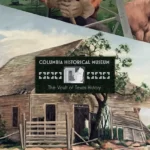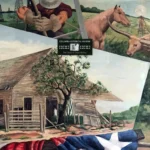History of West Columbia, Texas
Introduction: The Birthplace of Texas Governance
Welcome to West Columbia, Texas, a small town with a massive place in Texas history. Tucked away in Brazoria County, West Columbia may look like a quiet community today, but it once held the distinguished title of the first capital of the Republic of Texas.
This guide will take you on a journey through the history of West Columbia, Texas, offering insight into its development, the key historical figures involved, and the major events that shaped this small yet vital community.
Early Inhabitants and Spanish Influence
Long before settlers arrived, the land that would become West Columbia was home to Native American tribes, most notably the Karankawa people. They lived off the Gulf Coast and Brazos River, hunting, fishing, and navigating this lush and water-rich region.
In the 16th and 17th centuries, Spanish explorers began venturing into the area. These expeditions brought Spanish missions and land grants, but the region remained largely unsettled for many years. The Spanish influence, however, would lay the groundwork for the future establishment of Texan municipalities and legal systems.
Founding of Columbia in 1826
The modern story of West Columbia begins in 1826, when a man named Josiah H. Bell founded the town of Columbia along the Brazos River. Bell, who was part of Stephen F. Austin’s “Old Three Hundred” colonists, saw the potential of this location for agriculture and commerce. The land was fertile, and the river offered easy transport for goods like cotton and sugarcane.
By the late 1820s and early 1830s, Columbia was growing rapidly, supported by a mix of plantation agriculture and river trade. It became a hub for settlers moving into Mexican Texas.
Capital of the Republic of Texas (1836)
One of the most pivotal moments in the town’s history came in 1836, shortly after Texas won independence from Mexico. Following the signing of the Texas Declaration of Independence at Washington-on-the-Brazos and the defeat of Santa Anna’s forces at San Jacinto, Columbia was named the first capital of the Republic of Texas.
From September to December 1836, Columbia hosted the fledgling government of Texas. The first Congress of the Republic of Texas convened here, and Sam Houston was inaugurated as the first President. Here, critical decisions were made that shaped the future of the new nation.
Why the Capital Moved to Houston
While Columbia was historically significant, it was not ideally suited for long-term governance. The town lacked proper housing and infrastructure to support a growing government. As a result, the capital was soon moved to Houston in early 1837. Later, the capital would move again to Austin, where it remains today.
Despite losing its capital status, Columbia continued to be a vital part of Texas’ early development.
The Rise of Agriculture and Plantation Economy
After the capital moved, Columbia returned to its agricultural roots. The surrounding land was perfect for cotton plantations, and by the mid-1800s, the area became known for its slave-based economy. Wealthy landowners and enslaved laborers worked the land, producing cotton, corn, and sugarcane that were transported via the Brazos River.
Riverboats were a common sight, and the town thrived thanks to its strategic river location and growing demand for Southern cash crops.
Civil War and Reconstruction Era
During the Civil War, Columbia, like much of Texas, supported the Confederacy. Many men from the area served in Confederate regiments, and the town experienced economic strain during the war years.
After the war ended in 1865, the Reconstruction era brought major social and economic changes. The end of slavery deeply impacted the plantation economy, and many formerly enslaved people stayed in the region, establishing freedmen communities and churches. Though progress was slow and often met with resistance, the period laid a foundation for change.
The Great Storm of 1900 and Economic Shifts
At the turn of the 20th century, Columbia was still a rural farming community. But like many towns on the Texas Gulf Coast, it suffered greatly during the Galveston Hurricane of 1900. Flooding and strong winds reached far inland, damaging homes and crops.
In response to this and other economic pressures, the town began shifting away from large-scale agriculture to more diverse economic pursuits, including small businesses and oil exploration.
Oil Boom and Industrial Growth in the 20th Century
In the 1920s and 1930s, the discovery of oil in nearby regions brought new life to West Columbia. Oil derricks and refineries started popping up across Brazoria County, attracting workers and businesses.
This marked a transition from agrarian to industrial life for many residents. The discovery of natural gas and the development of the petrochemical industry provided economic stability through much of the 20th century.
New schools, roads, and infrastructure projects helped modernize the town, making it more livable and connected to the Houston metropolitan area.
Becoming “West” Columbia in 1957
You might be wondering why the town is called West Columbia instead of just Columbia. The change came in 1957, when the name was officially altered to avoid confusion with another Columbia located in East Texas.
The renaming helped preserve the town’s unique identity while still honoring its historical roots. From that point on, West Columbia has proudly claimed its place as the original capital of the Republic of Texas.
Preserving the Past: Historical Sites and Museums
West Columbia is deeply committed to preserving its historic legacy. Today, you can visit landmarks like the Columbia Historical Museum, which houses artifacts from the Republic era, the Civil War, and the town’s early settlers.
Another must-see is the First Capitol Replica, a reconstruction of the original building where the Republic’s first Congress met. Though the original structure is gone, this tribute helps visitors imagine what it was like to govern a young nation in the wilds of Texas.
Nearby, you’ll also find the Varner-Hogg Plantation, once owned by Texas Governor James S. Hogg. This state historic site gives insight into plantation life and the transition into post-slavery Texas.
West Columbia in Modern Times
In the 21st century, West Columbia has become a quiet yet vibrant community with a strong sense of identity. The town serves as a gateway to Texas history, attracting tourists, historians, and curious travelers alike.
Modern West Columbia is home to small businesses, excellent schools, and community events that bring neighbors together. The oil and gas industries still provide jobs, but there is also growth in healthcare, education, and tourism.
While it’s no longer a political capital, West Columbia remains a symbol of Texan independence and resilience.
Conclusion: The Spirit of Texas Lives in West Columbia
To understand Texas history, you have to start with West Columbia. From its days as a Native American homeland, through colonization, revolution, and its brief moment as the capital of an independent republic, this town has seen it all.
Though small in size, West Columbia’s contribution to Texas is immeasurable. It stands as a testament to bold beginnings, the fight for freedom, and the enduring spirit of the people who shaped this land.
So next time you’re driving through Brazoria County, take a detour into West Columbia. Walk its streets, visit its museums, and step into the pages of Texas history. You might just find that the past is very much alive here—and it has a story worth telling.











